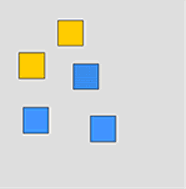I love using Pattern Blocks with students. They are a great way to show fractions for older students and the younger students can build items with them while getting familiar with different shapes.
The directions for the K-2 section:
Pattern blocks are great for making and describing patterns. To complete this activity:
- Create a pattern by combining trapezoid and triangle blocks.
We could describe this pattern as "a square block followed by a triangular block". We often shorten descriptions in math so it takes less space to write. One common way to shorten a description is to use single letters in place of words.
For example we can describe the "a square block followed by a triangular block" pattern as an AB pattern. We call the square block "A" and the second block "B".
If you connect 3 "A" blocks together, you would have an AAA pattern. Likewise, if you combined three "B" blocks together you would have a BBB pattern.
- Make a wall using an ABAB pattern.
- Make a star using an AAAAAA pattern.
The directions for the 3-5 section:
- Add 5 squares to the workspace.
- Color 3 squares blue.
You describe the result as: "3 of the 5 squares are blue".
A mathematical description would be "3/5".
Distinguishing and describing parts of a group is an important introduction to rational numbers.
The directions for the 6-8 section:
- Consider how each pattern block can be a whole unit, or part of a larger whole unit.
If you call the blue diamond pattern block 1 unit, which pattern block would be 1/2 a unit?
If you call the yellow hexagon 1 unit, which pattern block would be 1/2 unit?
If the blue diamond is 1/2 unit, make a shape that is 1 unit.
If the blue diamond is 1/4 unit, make a shape that is 1 unit.
If the green triangle is one unit, which pattern block is equivalent to three units?
If the green triangle is one unit, which pattern block is equivalent to six units?
- Make a shape that is 2 1/2 times the size of a green triangle.
- Make a shape that is 3 1/2 the size of a blue diamond.
Any shape can be a whole unit, or a part of a larger unit. Whole numbers describe when a shape is a whole unit, or a multiple of a whole unit. Rational numbers can describe when a shape is part of a larger whole.
The directions for the 9-12 section:
- Consider how each pattern block can be a whole unit, or part of a larger whole unit.
If you call the blue diamond pattern block 1 unit, which pattern block would be 1/2 a unit?
If you call the yellow hexagon 1 unit, which pattern block would be 1/2 unit?
If the blue diamond is 1/2 unit, make a shape that is 1 unit.
If the blue diamond is 1/4 unit, make a shape that is 1 unit.
If the green triangle is one unit, which pattern block is equivalent to three units?
If the green triangle is one unit, which pattern block is equivalent to six units?
- Make a shape that is 2 1/2 times the size of a green triangle.
- Make a shape that is 3 1/2 the size of a blue diamond.
Any shape can be a whole unit, or a part of a larger unit. Whole numbers describe when a shape is a whole unit, or a multiple of a whole unit. Rational numbers can describe when a shape is part of a larger whole.
So as you can see, you can vary levels when playing with pattern blocks. I have only used them with the younger students and they absolutely love building things with them.








